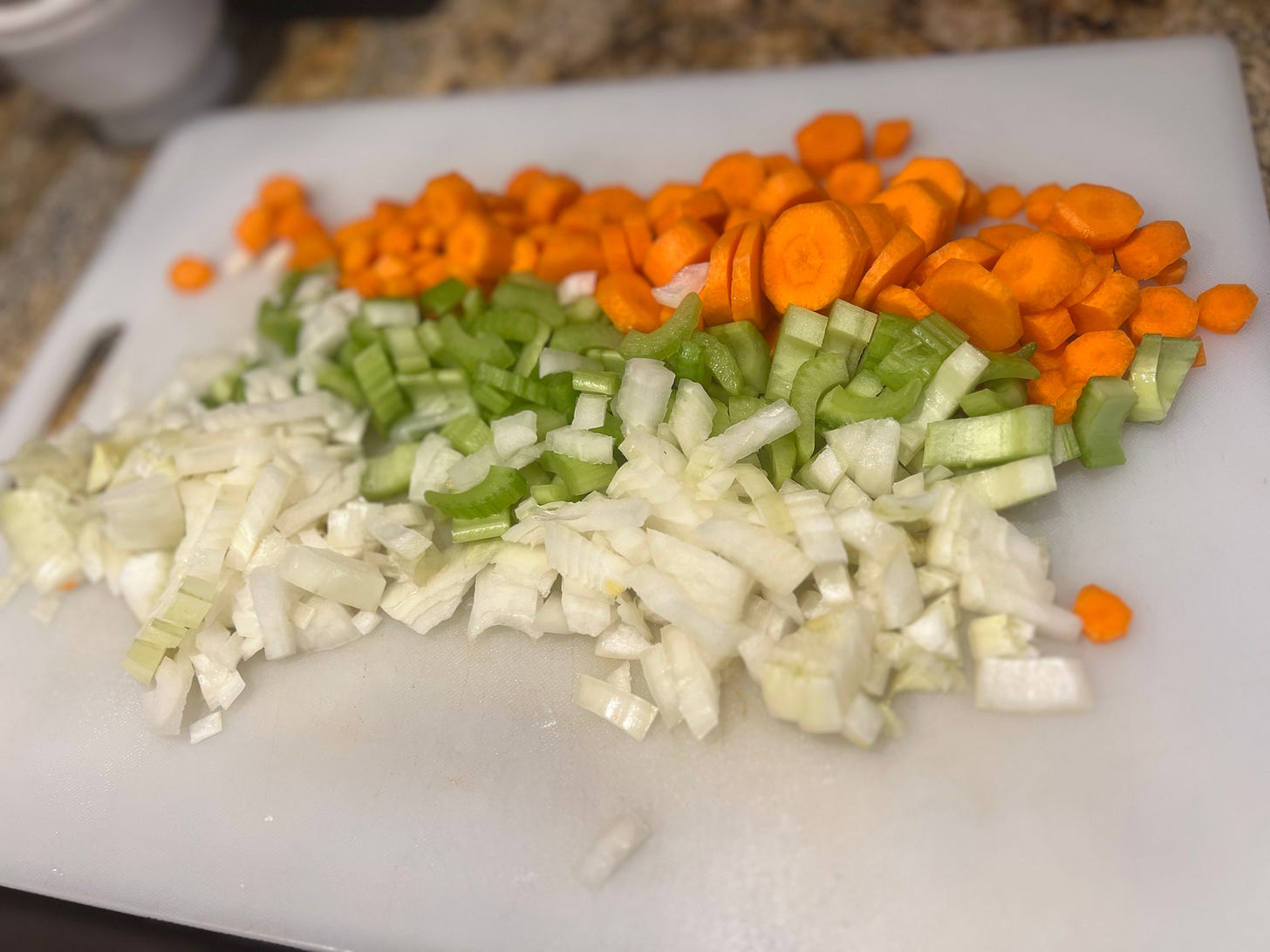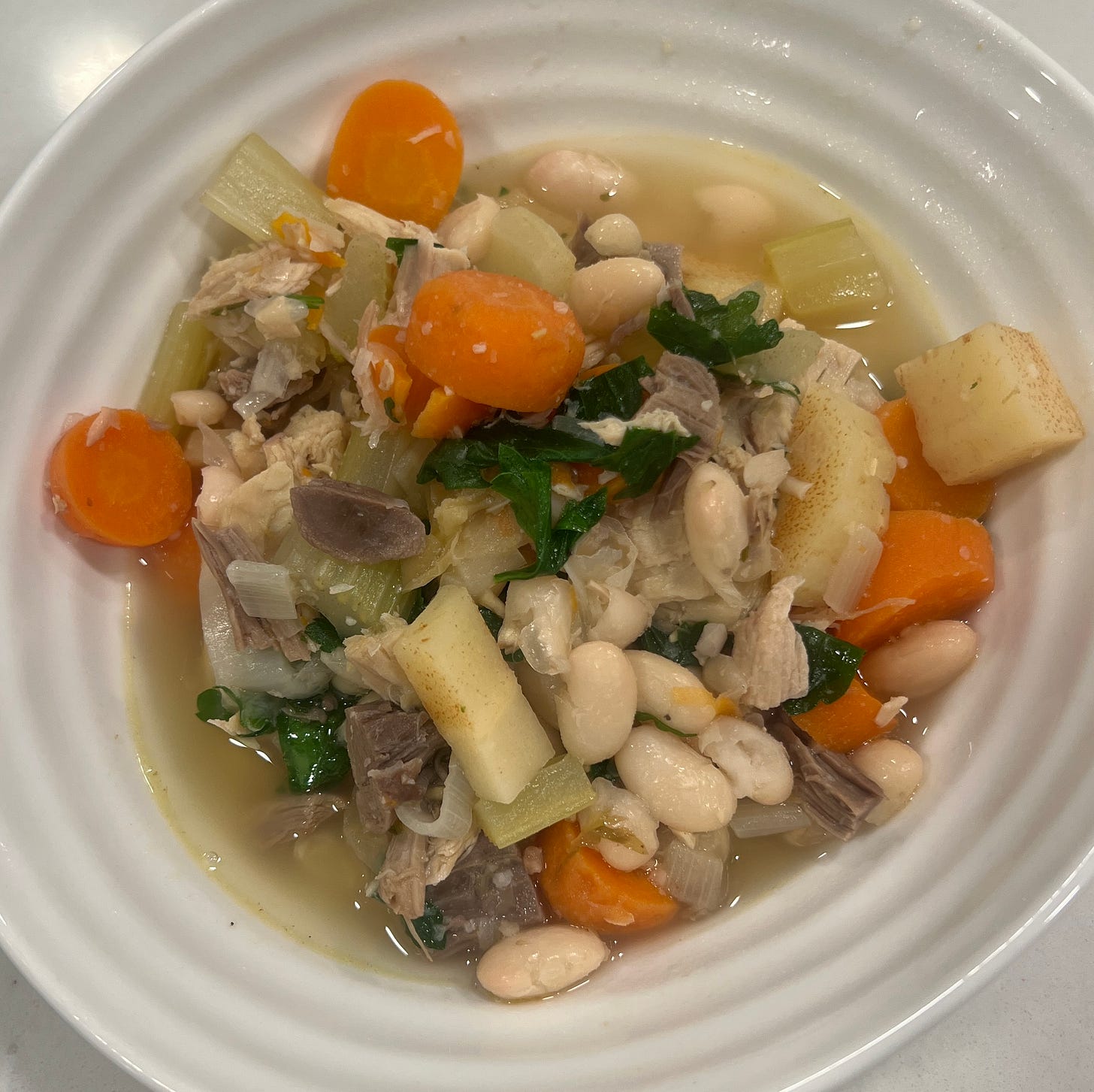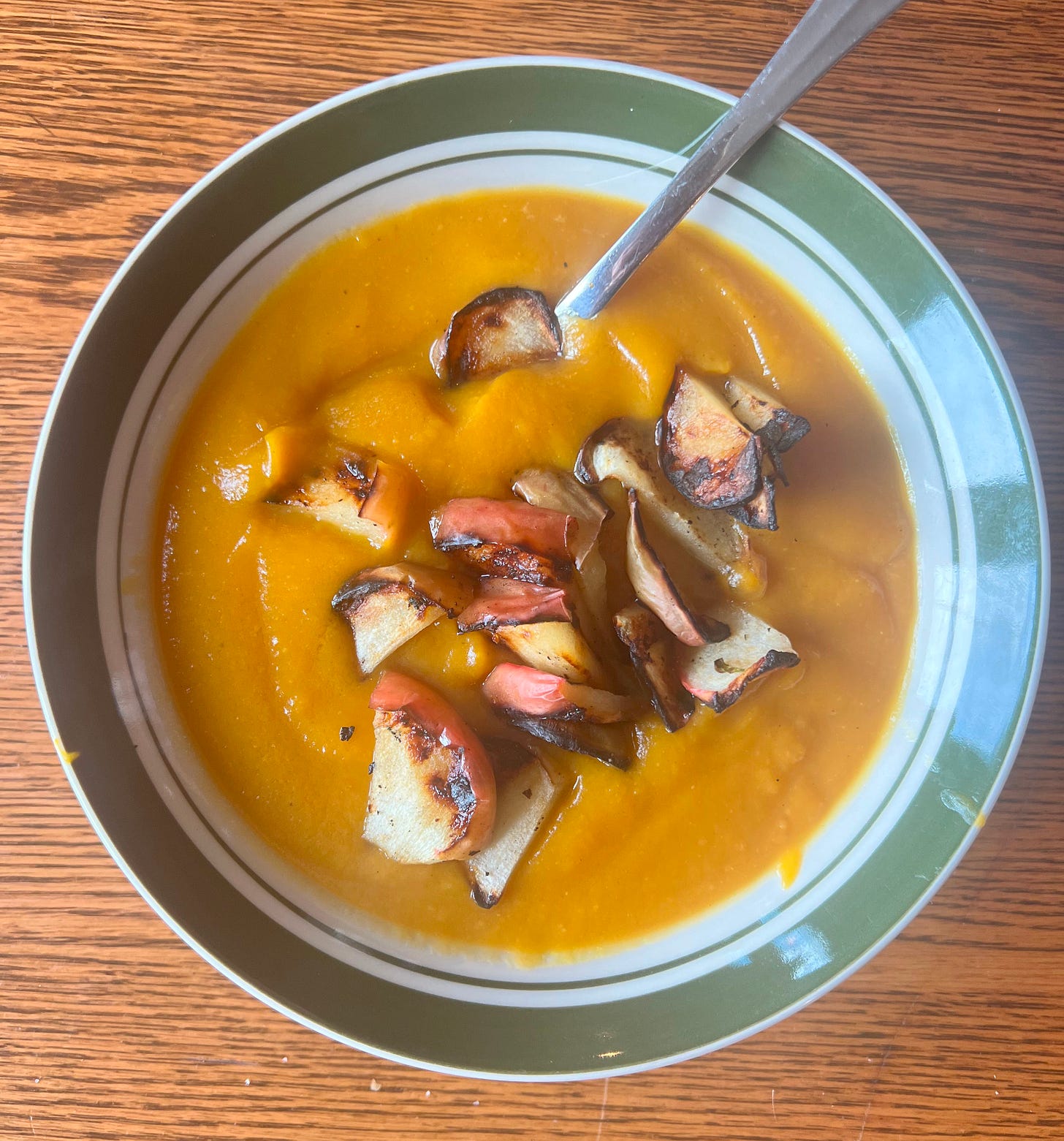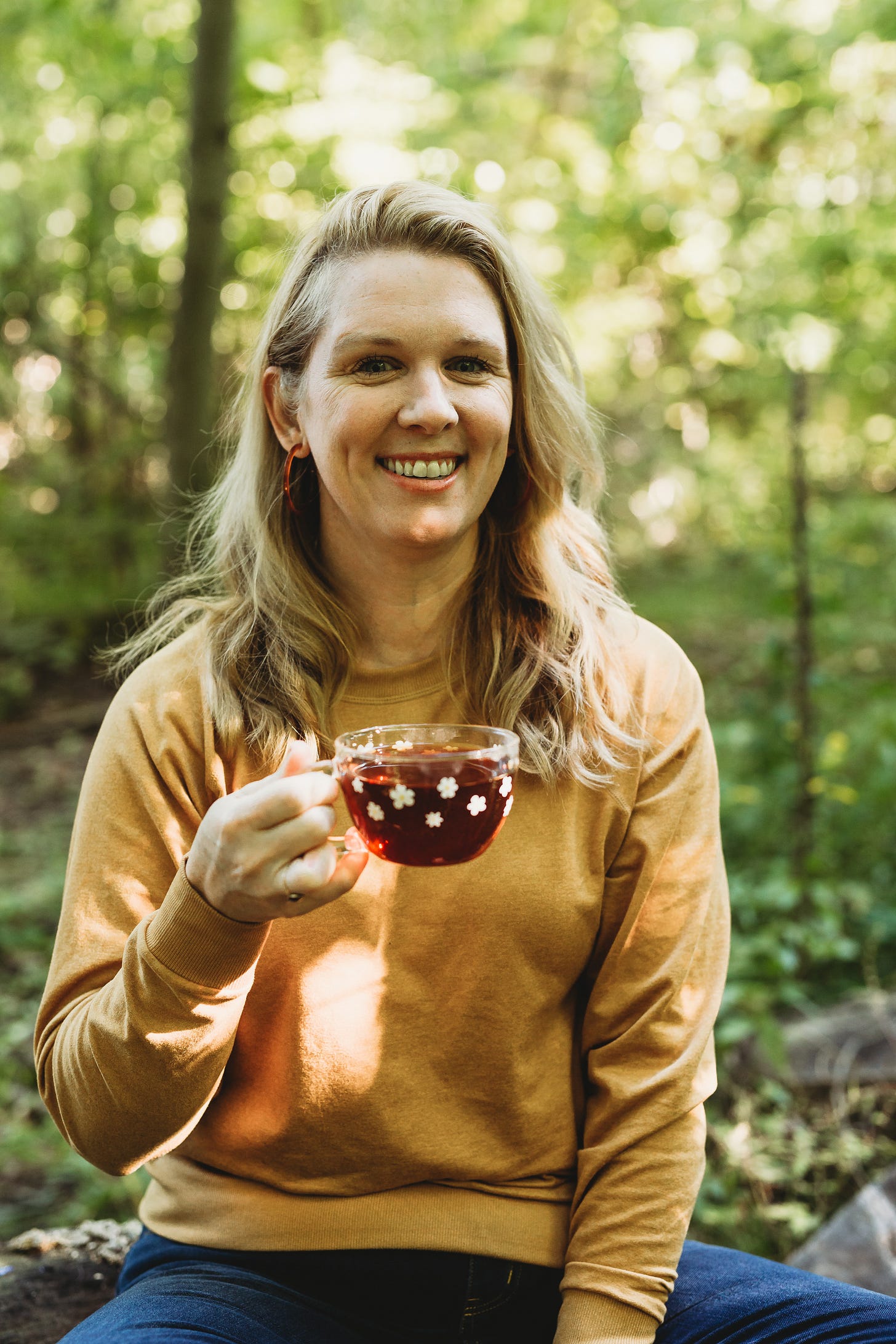You don't need a recipe to make soup
a vote for trusting yourself in the kitchen.
Let me start by saying this: I have nothing against recipes. I like them as a source of inspiration, a quick grocery-list cheat, and sometimes, a source of basic cooking information I don’t have at the top-of-mind ready - like how long a specific cut of meat may need to stay in the oven at a specific temperature. And when I’m learning a totally new-to-me process, like making cheese or sourdough bread, I lean pretty heavily on recipes until I’ve got my sea legs.
The magic of developing a relationship with your kitchen
For the past week I’ve been locked in a head-to-head battle with my sourdough starter.
But no matter how helpful a recipe may be at first, the law of diminishing returns always applies at some point. It’s similar to how I feel about GPS mapping: using it once or twice, to get to a place I’ve never been, is helpful. Continuing to get turn-by-turn directions to a place I go over and over and over, however? It just hijacks the part of my brain that would otherwise have learned the way. It’s not the map that’s the problem; it’s the way I reflexively rely on it to feed me information I’d have been better off committing to memory. The more I turn to that external source to “help” me, the less I trust myself to be able to figure it out on my own.
(Also, I don’t know about you, but I do this thing where I read the directions of a new-to-me recipe painstakingly four times before I start, but still manage to completely miss a step, or mis-gauge when dinner will be ready; the same way I obsessively check Google Maps when I’m going somewhere, even a place I’ve been a dozen times before. I’m so, so much better off letting go of the “script” and letting muscle memory take over.)
And while it may be true that we like recipes, and even prefer recipes, I will die on this hill: for most dishes, we do not actually need recipes.
That’s especially true for simple, timeless, hard-to-mess-up dishes. Like, say, soup.
We all know what soup looks like. We all know what soup tastes like. We do not need a cookbook, a Food Network show, or Pinterest to tell us whether ingredients tossed together in a pot qualify as soup.
Now, it’s true that we might have a better shot at creating something delicious if we follow a recipe the first time or two - just to get the ratio of liquid and meat and veg and beans and/or pasta and seasonings and fat and acid and salt more or less right.
But by, say, the third time making a specific soup I think we’re better off if we let instinct, reason, and our own understanding of what soup is take over. The sooner we can trust ourselves to be able to throw together a pot of soup all on our very own understanding of soupness, the sooner we’ll feel empowered to take on more and more complicated kitchen tasks without so much external scaffolding.
Soup should not require much of us, friends. It’s liquid with some solid foods simmered in it and hopefully some seasonings to make it taste yummy. It should be comforting both to eat and to make. Soup is peasant fare, and people - even plenty of illiterate people who never saw a cookbook in their lives - have been making soup ever since there were pots to hold it.
I am currently enjoying Ruth Goodman’s book The Domestic Revolution: How the Introduction of Coal into Victorian Homes Changed Everything. In the book, Goodman goes into a lot of detail about how the medieval staple dish, “pottage” - essentially a thick stew of grain, vegetables, and sometimes meat cooked in a cauldron in the hearth - became more liquid during the rise of coal-fueled cooking. The birth of soup! And I’m going to guess most of those medieval housewives didn’t obsessively check recipes as they made their daily meals, either.
There’s no need to stress. It’s just soup.
The beauty of it is, once you trust your basic understanding of what soup is and how soup works you can improvise endlessly on the formula. Chicken-noodle becomes chicken-bean. Beef-barley becomes beef-potato. You can throw in whatever veggies are starting to wilt in the drawer and they’ll always fit in.
No stress. It’s just soup.
In the spirit of don’t-stress-it’s-just-soup, here’s my basic - and extremely adaptable - soup formula:
First, I chop, dice, or finely slice (or some mix of the above) some carrot, celery, and onion and heat them in a skillet with fat (butter, oil, bacon grease or another animal fat; all will get the job done.) Depending on how much soup I want to make, I’m usually working with about one medium sized onion, two stalks of celery, and anywhere from three to six carrots.
I let these sweat/sauté at a middling temperature for a while (I want everything to soften and gently brown, but I’m not really going for a high-heat sear), until the whole kitchen smells incredible. If I have other veggies that need to get used up, I chunk/chop/dice them and toss them into the pot, too. Now I mince up 3-4 cloves of garlic and let it sit on the cutting board while I wait for the veggies, especially the onion, to get delightfully soft and golden and fragrant. Then I add the garlic, turn down the burner a smidge, and let it get ever so slightly golden too.
By the way, this whole delicious-smelling process - which kicks off the majority of my kitchen adventures - is maybe my very favorite part of cooking. Savor it!
If I want the meat to be browned, I add it (diced, cubed, or shredded) now.
Then I add turn up the burner to medium-high and add liquid: stock, broth, wine, water, or some combo of the above. How much? It depends. Does it look like soup, I ask myself? If not - if it looks more like pudding or stew - I add more liquid.
Or maybe it’s too watery. I may whisk in flour at this point for a thicker consistency. Or if I want a creamy consistency, I could add cream or coconut milk.
Trust your eyes. They know what soup looks like.
Then I add the other ingredients: meat if I haven’t put that in yet, maybe root veggies like potatoes or parsnips, maybe beans or noodles. I add these in the order that seems most logical based on whether these ingredients are raw or perhaps being repurposed; whether they’re finely diced or in large chunks. If I’m making a soup with canned beans, they will take less time to cook than if I am using raw potatoes so I would wait longer to add them; while soaked-but-not-simmered dry beans will take longer than potatoes. It helps to have a basic working knowledge of how long-ish different ingredients take to cook, but if you undercook it or overcook it a little, you will live and it will probably still taste good.
An immersion blender may be involved at some point, but you don’t have to stress about that until you’re ready.
Toward the end, I add spices and herbs. Thyme, rosemary and lemon are classic combos. So are ginger and turmeric. Or cumin and paprika and a dash of chili powder and lime. Can’t go wrong with any of those, but you can also improvise: it’s pretty hard to mess up a soup if you lean on flavors you’re familiar with and already know you like.
There aren’t any hard-and-fast rules. Turmeric can also go well with cumin. Thyme is delicious with ginger. Release the grip of all those old Food Network competition shows and all their talk of “flavor profiles”. You’re just here to make something edible. There is no cash prize at stake and there’s (probably) no camera in your kitchen.
Once you’ve got all the ingredients together, let it simmer as long as it needs to but not longer. However, it’s totally OK if it simmers longer than it needs to. It might be a bit soft but it will still be food (If it gets too soft, this is a perfect opportunity to pull out your immersion blender1.)
Don’t forget salt and pepper. Probably more salt than you think you need.
Is my way the “right” way? Are there better, or more officially-recommended, ways to make soup? Who cares!? It’s just soup.
Hack off a hunk of crusty bread if you have it. Eat the soup with whatever spoon you prefer.
Repeat and repeat and repeat until you could make soup in your sleep: with whatever meat is leftover from dinner two nights ago, with whatever wilted veggies are lurking in the back of the produce drawer, with whatever starch you’re in the mood for today.
Recipe books and cooking shows and meal kit services have their place, but don’t let them convince you that making soup is more complicated than throwing a bunch of stuff together and cooking it in water.
Kitchen skills are a cornerstone of frugality. They help us discover our resilience. They serve as a reminder that we, all on our own, possess the ability to Know How To Do Things - how to cut up food and add liquid and cook it and feed it to ourselves and others - without the help of celebrity chefs, influencers, or special appliances.
For hundreds and hundreds of years, people have been throwing things in a pot, adding liquid, and calling it dinner. You can, too.
It’s all good. It’s just soup.
About me:
Hi! I’m Meagan, an author, podcaster, and midlife mom of five (mostly grown) kids. Here at The Kettle, I share my thoughts on how to live wisely and well in a manic modern world, and I look forward to hearing yours. If you want to connect more deeply, the private chat, including weekly Co-Create Circles and other occasional bonus offerings, is open to paid members. I’m looking forward to getting to know you!
I’m sparing with my Amazon affiliate links these days, but I have had these same immersion blender for over 15 years and still use it multiple times per week - so I highly recommend.











Love the freedom this post gives - I’m inspired and foresee some soup play in my kitchen in the near future :)
Ha, I love this. I've been making a lot of soup recipes for my blog this winter, and I keep fighting myself about adding "or more, to your taste" after every ingredient. At one point, I'm like, why am I even writing a recipe? Isn't EVERYTHING in soup "to your taste"??? I should just provide a list of ingredients and be like "you do you" for the method. 🤣 because it's so true. Soup is soup...it will get there eventually, and it's okay to add in whatever you want.